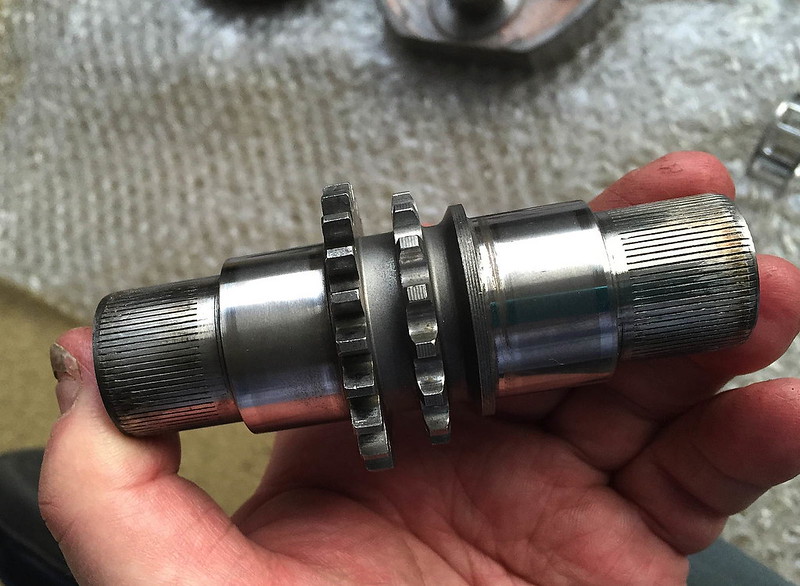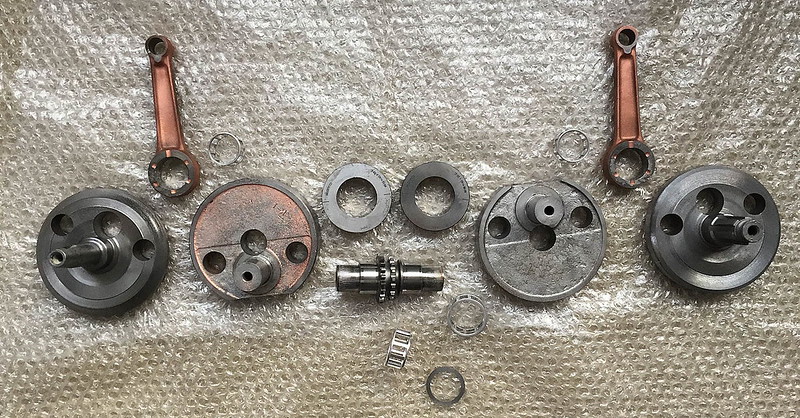-
DJM
- honda305.com Member
- Posts: 553
- Joined: Thu Oct 09, 2003 1:54 pm
- Location: Chesterfield UK
Post
by DJM » Fri Dec 21, 2018 6:36 pm
Mike in Idaho wrote,
If it was that easy to twist a crank out of register it would get twisted every time you opened the throttle wide open. In first gear with the output shaft nut getting say, 50 foot pounds of torque, that torque figure would be divided by the ratio of first gear(2.788:1) then divided farther by the ratio of the primary drive(3.13:1)= 5.73 foot pounds at the alternator bolt. I think the crank will handle that.
These figures might be true if the suggestion was to hold the gearbox output sprocket but I thought the suggestion was to hold the alternator rotor while tightening the engines primary drive sprocket, in that case the applied torque would be straight along the crank from one end to the other?
I'm not sure what point you're making here but, from the CB77 Owners handbook max. torque for one of these engines is 18.08 ft.lbs which would me measured at the crank (sprocket)
-
G-Man
- honda305.com Member
- Posts: 5678
- Joined: Wed Mar 25, 2009 5:17 pm
- Location: Derby, UK
-
Contact:
Post
by G-Man » Sun Dec 23, 2018 3:42 am
Standard torque for a 20mm nut is around 350 Ft lbs, but this is a thin nut with a pitch of 1mm so I guess a tightening figure of around 50-70 Ft.lbs would do the job.
G
DJM wrote:Mike in Idaho wrote,
If it was that easy to twist a crank out of register it would get twisted every time you opened the throttle wide open. In first gear with the output shaft nut getting say, 50 foot pounds of torque, that torque figure would be divided by the ratio of first gear(2.788:1) then divided farther by the ratio of the primary drive(3.13:1)= 5.73 foot pounds at the alternator bolt. I think the crank will handle that.
These figures might be true if the suggestion was to hold the gearbox output sprocket but I thought the suggestion was to hold the alternator rotor while tightening the engines primary drive sprocket, in that case the applied torque would be straight along the crank from one end to the other?
I'm not sure what point you're making here but, from the CB77 Owners handbook max. torque for one of these engines is 18.08 ft.lbs which would me measured at the crank (sprocket)
'60 C77 '60 C72 '62 C72 Dream '63 CL72
'61 CB72 '64 CB77 '65 CB160
'66 Matchless 350 '67 CL77
'67 S90 '77 CB400F
-
LOUD MOUSE
- honda305.com Member
- Posts: 7817
- Joined: Mon Aug 15, 2005 8:23 am
- Location: KERRVILLE, TEXAS
Post
by LOUD MOUSE » Sun Dec 23, 2018 10:18 am
50-70 Ft.lbs would do the job.
Surely you jest G.
There is a large sort of crush washer on that end of the crank. ..................lm
G-Man wrote:Standard torque for a 20mm nut is around 350 Ft lbs, but this is a thin nut with a pitch of 1mm so I guess a tightening figure of around 50-70 Ft.lbs would do the job.
G
DJM wrote:Mike in Idaho wrote,
If it was that easy to twist a crank out of register it would get twisted every time you opened the throttle wide open. In first gear with the output shaft nut getting say, 50 foot pounds of torque, that torque figure would be divided by the ratio of first gear(2.788:1) then divided farther by the ratio of the primary drive(3.13:1)= 5.73 foot pounds at the alternator bolt. I think the crank will handle that.
These figures might be true if the suggestion was to hold the gearbox output sprocket but I thought the suggestion was to hold the alternator rotor while tightening the engines primary drive sprocket, in that case the applied torque would be straight along the crank from one end to the other?
I'm not sure what point you're making here but, from the CB77 Owners handbook max. torque for one of these engines is 18.08 ft.lbs which would me measured at the crank (sprocket)
-
mike in idaho
- honda305.com Member
- Posts: 411
- Joined: Sun Jan 29, 2012 9:18 pm
- Location: orofino, idaho
Post
by mike in idaho » Sun Dec 23, 2018 2:35 pm
"I'm not sure what point you're making here but, from the CB77 Owners handbook max. torque for one of these engines is 18.08 ft.lbs which would me measured at the crank (sprocket)"
It doesn't matter what the engine produces for torque, I was just pointing out the force needed to balance out 50 foot pounds, on the sprocket nut, with the trans in low gear. Seems like a better way to hold the shaft from turning then jamming something in the primary chain. Easier too, since the alternator bolt is already uncovered and right next to the rear sprocket. I've worked on enough brand X two-stroke twin cranks to be familiar with crankshaft twisting. The Honda crank is quite a bit different with some pretty robust splines between the inside flywheels and well supported by four main bearings in a rigid, horizontally split crankcase.
'65 YG1
'65 CB160
'66 CL160
'66 CL77
'78 XS650
'79 GL1000
'69 T100R
'68 TR6
'69 T120
'72 750 Commando
my company car is a Kenworth
-
G-Man
- honda305.com Member
- Posts: 5678
- Joined: Wed Mar 25, 2009 5:17 pm
- Location: Derby, UK
-
Contact:
Post
by G-Man » Mon Dec 24, 2018 3:05 am
DJM Wasn't talking about undoing the nut with the chain in place. Just locking the two sprockets, like the Villiers tool does.
Not much of a spline in those cranks. Just a some shallow scores on the center pin to try and improve the friction between pin and flywheel.

In cranks like TZ series Yamahas they used to weld the crankpins to stop them slipping.

G
mike in idaho wrote:"I'm not sure what point you're making here but, from the CB77 Owners handbook max. torque for one of these engines is 18.08 ft.lbs which would me measured at the crank (sprocket)"
It doesn't matter what the engine produces for torque, I was just pointing out the force needed to balance out 50 foot pounds, on the sprocket nut, with the trans in low gear. Seems like a better way to hold the shaft from turning then jamming something in the primary chain. Easier too, since the alternator bolt is already uncovered and right next to the rear sprocket. I've worked on enough brand X two-stroke twin cranks to be familiar with crankshaft twisting. The Honda crank is quite a bit different with some pretty robust splines between the inside flywheels and well supported by four main bearings in a rigid, horizontally split crankcase.
'60 C77 '60 C72 '62 C72 Dream '63 CL72
'61 CB72 '64 CB77 '65 CB160
'66 Matchless 350 '67 CL77
'67 S90 '77 CB400F
-
Seadog
- honda305.com Member
- Posts: 1272
- Joined: Thu Dec 25, 2014 9:54 am
- Location: Cape Cod, MA
Post
by Seadog » Mon Dec 24, 2018 3:58 pm
G, is this Villers tool just an example, or will it fit the Superhawk? Good to have if it will work with the 305 engine.
-
LOUD MOUSE
- honda305.com Member
- Posts: 7817
- Joined: Mon Aug 15, 2005 8:23 am
- Location: KERRVILLE, TEXAS
Post
by LOUD MOUSE » Mon Dec 24, 2018 4:50 pm
What is a VILLER'S Tool?. ......................lm
G-Man wrote:DJM Wasn't talking about undoing the nut with the chain in place. Just locking the two sprockets, like the Villiers tool does.
Not much of a spline in those cranks. Just a some shallow scores on the center pin to try and improve the friction between pin and flywheel.

In cranks like TZ series Yamahas they used to weld the crankpins to stop them slipping.

G
mike in idaho wrote:"I'm not sure what point you're making here but, from the CB77 Owners handbook max. torque for one of these engines is 18.08 ft.lbs which would me measured at the crank (sprocket)"
It doesn't matter what the engine produces for torque, I was just pointing out the force needed to balance out 50 foot pounds, on the sprocket nut, with the trans in low gear. Seems like a better way to hold the shaft from turning then jamming something in the primary chain. Easier too, since the alternator bolt is already uncovered and right next to the rear sprocket. I've worked on enough brand X two-stroke twin cranks to be familiar with crankshaft twisting. The Honda crank is quite a bit different with some pretty robust splines between the inside flywheels and well supported by four main bearings in a rigid, horizontally split crankcase.
|




